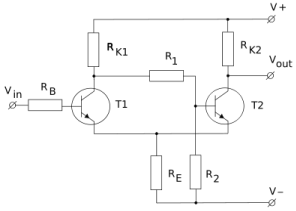Schmitt trigger with two transistors
In positive-feedback configuration used in implementation of the Schmitt trigger, most of the complexity of comparator's own implementation is unused. Therefore, it can be replaced with 2 cross-coupled transistors (that is the transistors which would otherwise implement the input stage of comparator). An example of 2-transistor-based configuration is illustrated below. The chain RK1 R1 R2 fixes the base voltage for the transistor T2. This divider, is affected by transistor T1, providing higher voltage if T1 is open. Thus the threshold voltage for switching between the states depends on present state of trigger.

For NPN transistors, when the input voltage is below the shared emitter voltage, T1 does not conduct. The base voltage of the transistor T2 can be determined by the mentioned divider. Because of negative feedback, the voltage at shared emitters should be almost as high as that set by divider so that T2 is conducting, and trigger output is in low state. T1 will conduct when the input voltage (T1 base voltage) increases slightly above the voltage across the resistor RE (emitter voltage). When T1 starts to conduct, T2 ceases to conduct, as the voltage divider now provides lower T2 base voltage while emitter voltage does not drop because T1 is drawing current across RE now. With T2 not conducting the trigger has transitioned to the high state now.
With the trigger in high state now, if input voltage lowers enough, current through T1 reduces, lowering the shared emitter voltage and raising base voltage for T2. As T2 starts to conduct, the voltage across RE rises, further reducing T1 base-emitter potential and T1 stops to conduct.
In high state, the output voltage is close to V+, but in low state it is still above V-. This may not be low to be a "logical zero " for digital circuits. This may need additional amplifiers following trigger circuit.
The circuit can be simplified: R1 can be replaced by a short circuit connection, connecting T2 base directly to the T1 collector, and R2 can be taken out and can be replaced with an open circuit. The key to its operation is that less current flows through RE when T1 is switched on (as a result of input current into its base) than when T1 is off, because turning T1 on turns T2 off, and T2, when on, provides more current through RE than does T1. With less current entering RE, the voltage across it will be lower, and so as the current gets going into T1 once, the input voltage must go lower to turn T1 back off as now its emitter voltage has been lowered. This Schmitt trigger buffer can also be turned into a Schmitt trigger inverter and another resistor saved in the process, by replacing RK2 with a short connection, and connecting Vout to the emitter of T2 instead of its collector. In this case, a larger value o f resistance should be used for RE as it now serves as the pull-down resistor on the output, lowering the voltage on the output when the output should be low, in spite of a serving as a small resistance only which is only intended to develop a small voltage across it that actually adds to the output voltage when it should be at a digital low.
Email based Electronics Devices and circuits assignment help - homework help at Expertsmind
Are you searching Electronics Engineering assignment help expert for help with Schmitt trigger with two transistors questions? Schmitt trigger with two transistors topic is not easier to learn without any external help? We at www.expertsmind.com offers free lecture notes for Electronics Devices and circuits assignment help and Electronics Devices and circuits homework help. Live tutors are available 24x7 hours for helping students in their Schmitt trigger with two transistors related problems. We provide step by step Schmitt trigger with two transistors question's answers with 100% plagiarism free content. We prepare quality content and notes for Schmitt trigger with two transistors topic under Electronics Devices and circuits theory and study material. These are avail for subscribed users and they can get advantages anytime.
Why Expertsmind for assignment help
- Higher degree holder and experienced experts network
- Punctuality and responsibility of work
- Quality solution with 100% plagiarism free answers
- Time on Delivery
- Privacy of information and details
- Excellence in solving electronics engineering questions in excels and word format.
- Best tutoring assistance 24x7 hours